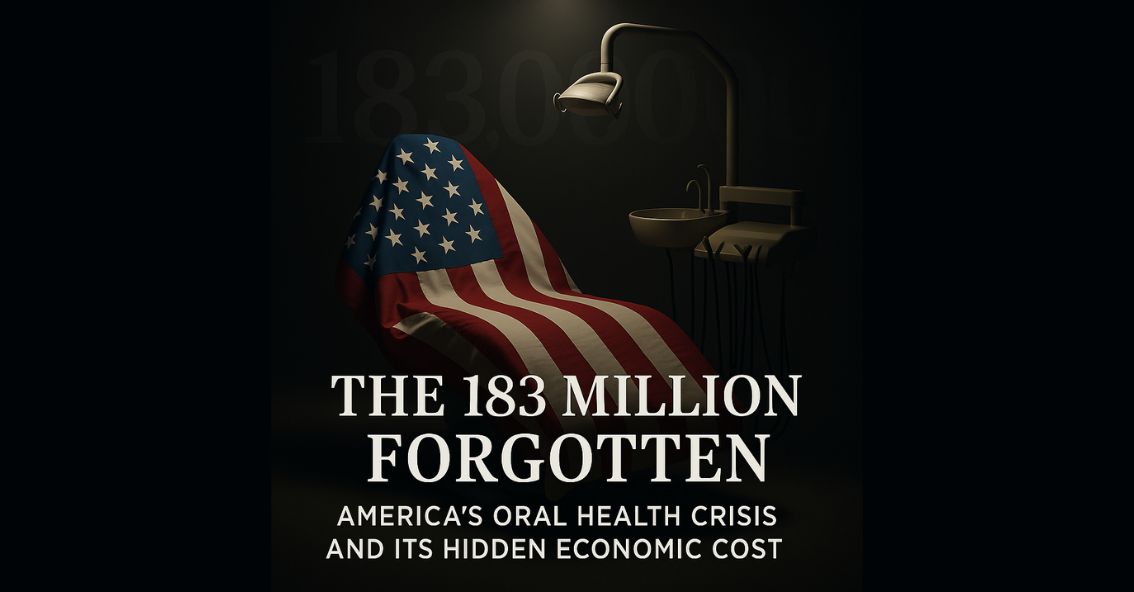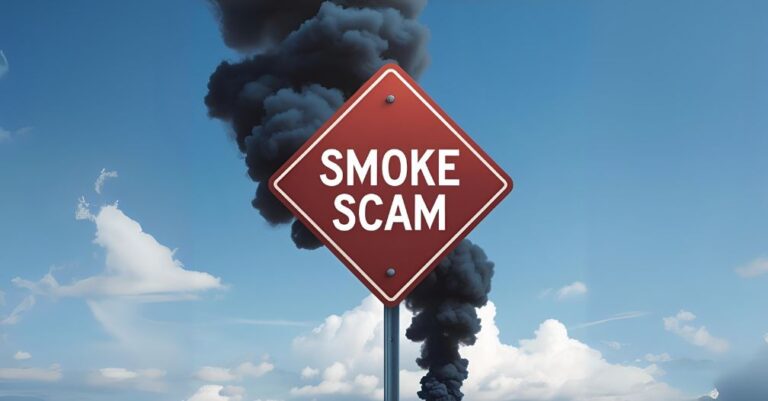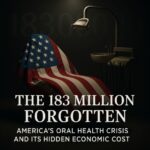The 183 Million Forgotten: America’s Oral Health Crisis and Its Hidden Economic Cost
From the Exiled Trenches of Our Profession
I have much to be grateful for, but the U.S. dental system is not one of them.
I write with respect for our profession and a deep commitment to its future, but also with a sense of urgency. Something is fundamentally broken in American dentistry and has been for far too long.
I am a U.S. citizen and a foreign-trained dentist with three master’s degrees. I teach privately yet remain shut out from academia. In this system, without a license, you are worth nothing. Citizenship and advanced education change nothing.
My story is not unique. Tens of thousands of highly qualified dentists living in the United States face the same barriers: costly, redundant schooling, underpaid residencies, bans on volunteering unless licensed first, and crushing debt, all while the nation faces a historic, acute workforce shortage.
The contradiction is glaring. A pool of skilled professionals is systematically excluded from addressing the very crisis they are trained to solve. What we face is not a shortage of talent, but a multilayered systemic failure that blocks highly trained dentists from serving, leaving millions without care, and dragging the profession further away from the global standards it claims to uphold.
Introduction: The National Crisis in Disguise
The collapse of America’s dental care system is not accidental. It is an engineered crisis, one that for decades has bled our economy, compromised our communities, and eroded the health of millions. Only 45% of Americans had a dental visit in 2022, leaving over 183 million Americans without preventive care.¹,²
The illusion that this is only a matter of public health obscures its true scale. It is a chronic economic crisis in disguise, costing an estimated $3.4 billion annually in emergency room visits for preventable dental conditions³ and $45 billion in lost productivity due to untreated dental disease in 2023.⁴
This is not a system malfunction. It is a system built to fail. A chronic force of economic erosion that dismantles growth, suppresses productivity, and widens inequity.
The economic toll extends well beyond patients. When dental practices close or never open, entire communities lose jobs, prescriptions, lab contracts, small businesses, insurance claims, and federal reimbursements. What disappears is not only health, but economic vitality. This system is not broken by accident; it is broken by design.
We cannot solve what we refuse to name. And this crisis has a name: Economic Dental Disintegration; the chronic collapse of oral healthcare and education systems that silently erodes national health and economic vitality.
It rests on three structural failures:
- A failed, outdated, and underperforming dental education system.
- A multiplying national workforce shortage spiraling out of control.
- A systemically marginalized access-to-care, engineered to serve the privileged few.
Failures at the Core
The roots of this crisis are structural, not incidental. Three failures underpin the collapse of access and equity in American dentistry: an outdated education model, a workforce shortage perpetuated by policy, and an access system designed for privilege. Unless these failures are confronted directly, dentistry will continue to frame the crisis as merely a healthcare issue while its deeper economic damage spreads unchecked.
Part I – A Failed Dental Education System
We train students to pass exams, not to treat patients. Graduates leave school burdened with debt, undertrained in oral surgery, and unprepared for the realities of practice. Many burn out before they ever open their doors, only to find themselves captive to the same insurance companies that dictate how little their care is valued.
Across the country, dental education has become theoretically heavy and clinically shallow:
- Surgical readiness is scarce.
- In-State tuition now averages over $350,000 for a DDS without living expenses.⁵
- Faculty ranks are shrinking, with fewer U.S. graduates choosing academia.
- Schools rely on international professionals to staff clinics yet deny them licensure.
The Faculty Crisis: Bottleneck by Credential
The shortage of dental faculty is no accident. It is a self-imposed bottleneck built on credentialing rules that bar qualified, internationally trained clinicians from academic roles.
Faculty are overstretched, forced to juggle supervision, administration, and fundraising. Students graduate with fewer mentors, less clinical oversight, and diminished preparation, while the very professionals who could fill these roles remain excluded.
The problem is not lack of candidates, but refusal to recognize talent already here. Academia clings to performative outreach and passive exclusion, deepening the shortage it claims to solve. The pipeline is not failing; it is designed to exclude.
Foreign-trained dentists, many with advanced postgraduate education and surgical expertise, are told to “start over.” They are forced into redundant programs, denied the chance to even volunteer, and equated with incompetence simply because their degree was earned abroad. We have confused licensure with competence and credentialing with merit.
As the ADA’s Health Policy Institute (2021) itself acknowledges: “In the last 10 years, about 88% of inflows have been new U.S. dental school graduates with remaining inflows coming from foreign-trained dentists, established dentists who reactivated an expired license, and dentists who came out of retirement”.¹³ In other words, foreign-trained dentists represent only about 7% of new workforce entries, despite their numbers and qualifications.
Every blocked educator, undertrained graduate, and untreated patient compounds the economic disintegration already hollowing out American dentistry.
Part II – A Workforce Shortage Sustained by Policy
The Health Resources and Services Administration (HRSA) reported a shortage of 10,877 dentists by the end of 2023.⁶ Hygienists and assistants are leaving the profession, faculty vacancies remain unfilled, and community clinics are stretched beyond capacity.
Yet the workforce to fix this shortage already exists. Over 100,000 foreign-trained dentists live in the United States. Fewer than 5% are licensed,¹² not because they lack the necessary skills, but because the system was never designed to include them. Blocking providers who speak the languages and understand the communities we claim to serve is inefficient and undermines care itself.
Instead, these professionals encounter:
• Residency bottlenecks: 1,500 applicants for five spots.
• Stipends below a living wage.
• A ban on volunteering without licensure.
• Underutilized GPR/AEGD programs that could be repurposed as supervised, licensure-track pathways if policy allowed.
If 10 percent of the 100,000 dentists served in Health Professional Shortage Areas (HPSAs), the shortage would shrink, access would expand, and patients would receive treatment.
Part III – The Economic Cost of Waste
The impact of these failures is staggering:
- Over 183 million Americans go without dental care each year.¹,²
- 75 million people live in a HPSA, and 58 million live in a dental HPSA.⁷
- 72 million adults (27%) lack dental insurance.⁸
- 1.8 million ER visits for non-traumatic dental conditions cost $3.4 billion.³
- $45 billion is lost annually in productivity due to dental-related absences.⁴
- Periodontal disease affects 47% of adults over 30 and nearly 70% of seniors.¹⁰
In many communities, access is no longer unequal. It is nonexistent. Veterans, seniors, low-income families, and entire regions are left without access to a dentist.
When we lose dentists, we do not just lose healthcare. We lose:
- Lab orders and prescriptions.
- Insurance claims and reimbursements.
- Payrolls, staff jobs, and small businesses built around clinics.
- Mortgages, car loans, and taxable income that sustain communities.
The False Dichotomy: Foreign vs. American
Who decided that being foreign-trained means being less capable?
If that were true, why do Americans travel abroad for dental care? Why do foreign-trained professionals chair departments at American dental schools? And foreign-surname Directors lead continuing education institutes?
The so-called “American Gold Standard” has become a gold-plated illusion. We measure quality by geography, not skill. That is not patient protection; it is discrimination disguised as regulation.
A true gold standard is measured by outcomes, access, and competence, not by where the diploma was issued.
Licensed-Qualified vs. Skill-Qualified
Licensing in the U.S. dental system is not always a safeguard. Too often, it is wielded as a weapon of exclusion.
Foreign-trained dentists, many from Latin America, Europe, and Asia, arrive with postgraduate training and years of surgical experience. Yet, their skills are dismissed as if they “do not count” on American soil. Meanwhile, U.S. graduates often emerge underprepared, needing mentorship for basic procedures.
Nowhere is the imbalance more evident than in dental therapy. In several states, hygienists can be trained to extract teeth legally,⁹ whereas internationally trained oral surgeons are required to start again as if they were novices.
According to Becker’s Dental (2024), approximately 100,000 foreign-trained dentists reside in the United States, yet only 5% practice clinically.¹² This gap reflects not a lack of talent but a failure of licensure systems to integrate qualified professionals.
This is not about safety. It is about protectionism, revenue, and bureaucratic inertia. In American dentistry, a license often proves to be mere paperwork, rather than a measure of competence.
Accountability Without Action
For nearly two decades, reports, panels, and commissions have documented America’s dental access crisis. The findings remain unchanged: millions go without care, the workforce is insufficient, and education remains misaligned with needs. Yet action never follows.
In 2008, U.S. Army Colonel Donn Grimes warned that the shortage of dentists was a threat to national security.¹¹ The military could not recruit or retain enough dental officers. Millions of Americans were already living in shortage areas. Seventeen years later, the problem only worsened:
- Dental education grows increasingly unaffordable and inaccessible.
- Foreign-licensed professionals remain blocked by policy and licensing bias.
- Burnout accelerates among hygienists and assistants.
- Rural and underserved areas remain abandoned.
- Even within the profession, conflict grows between dentists and hygienists over protocols, power, and pay.
The institutions charged with leadership, dental schools, associations, accrediting bodies, and policymakers have chosen inertia. They acknowledge shortages while excluding the very professionals who could help. They publish studies and convene panels but resist reform. The result is performative advocacy: statements without strategy, resolutions without timelines, policies without enforcement. Meanwhile, the crisis continues to deepen every year.
We do not need another roundtable to restate a 17-year-old problem. We need accountability with consequences, and reform that starts now.
Solutions: From Exclusion to Integration
To treat the whole person, our health system must finally recognize the link between oral and systemic health, and that recognition must begin with reforming dentistry itself.
Recent legislation in Florida, Texas, and Alabama has opened licensure pathways for physicians trained abroad. In Ohio, Global Cleveland reframed the issue entirely: this is not about immigration, but about economic reintegration, helping U.S. citizens and legal residents who have been trained abroad return home to serve their communities. Same as when a Veteran returns home from service abroad.
Dentistry can, and must, be the first profession to apply this model directly. A Dental Graduate Bill, patterned after medicine’s reforms and tailored for state-level adoption, would begin to close the gap.
Five Strategic Reforms
We do not need to invent new solutions. We need to implement those already within reach. Prevention must be the foundation, because it is always cheaper to prevent than to pay billions for avoidable ER visits.
- Modernize AEGD/GPR Programs → Make them supervised, state-approved licensure-track residencies, measured by clinical performance. Today, applicants must pass the INBDE before admission. Why not allow completion of the INBDE during or at the end of the program, as is already the protocol in undergraduate training?
- Incentivize Rural and Underserved Service → Offer conditional or limited licenses tied to years of service in shortage areas, where the deficit is most severe.
- Expand Credential Pathways → Create licensure routes based on validated surgical portfolios, international residencies, and supervised externships, anchored in competence, not bureaucracy.
- Address the Faculty Bottleneck → Recruit and empower globally experienced clinicians as faculty, filling critical vacancies and strengthening the training pipeline.
- Tie Reform to Economic Policy → Recognize dentistry as a driver of local jobs, small business vitality, and community stability. Workforce reintegration is economic development.
Dental Justice: A National Dental Reckoning
Why are we more comfortable pushing foreign-licensed dentists into dental hygiene than confronting the barriers that prevent them from practicing the one for which they were trained? That is not a solution. It is misallocation.
Here is the reality: if the United States did not face an oral health crisis, this debate would not exist. But we do, and it is profound.
The question becomes unavoidable: if the ADA, universities, and policymakers refuse to integrate foreign-licensed professionals, then what is their proposal to solve the access crisis? Silence is not a strategy. The nation deserves an answer.
Oral health must be treated as a fundamental right tied to dignity, productivity, and national well-being, not a privilege guarded by arbitrary barriers. Change will not come from inertia or another round of study. It demands leadership, collaboration, and implementation of solutions already within reach.
This is the story of every community without care, every qualified professional blocked, every patient in an ER instead of a dental chair.
The most profound form of discrimination is the unequal access to healthcare.
—Alan Arturo Zarzar, 2024 (inspired by Dr. Martin Luther King Jr., 1966)
References:
¹ ADA Health Policy Institute (2022). 45% of Americans visited a dentist
² U.S. Census Bureau (2022). U.S. population data
³ CareQuest Institute (2019). $3.4B in ER visits for non-traumatic dental conditions
⁴ CareQuest Institute (2023). $45B productivity loss from urgent oral needs
⁵ Master Student (2022). U.S. dental school tuition exceeds $350K
⁶ HRSA/DentalPost (2024). Shortage of 10,877 dentists in 2023
⁷ HRSA (2024). 75M Americans live in Health Professional Shortage Areas)
⁸ CareQuest Institute (2024). 72M adults lack dental insurance
⁹ The Pew Charitable Trusts (2022). States Expand Dental Therapy
¹⁰ CDC (2024). El Chaar, E. Journal of Oral Implantology. Periodontal disease affects 47% of adults over 30
¹¹ DTIC (2008). Colonel Donn Grimes. U.S. Army War College. The Shortage of Dentists: A Risk to National Security?
¹² Becker’s Dental (2024). How Foreign-Trained Dentists Can Bridge America’s Dental Care Crisis
¹³ ADA Health Policy Institute (2021). Supply of Dentists in the United States








